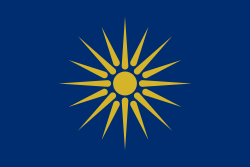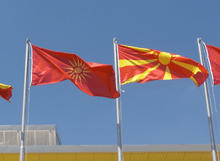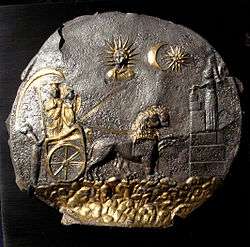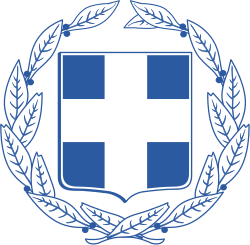Vergina Sun

The Vergina Sun - (Greek: Ήλιος της Βεργίνας) (also known as the Star of Vergina, Macedonian Star, or Argead Star) is a rayed solar symbol appearing in ancient Greek art from the 6th to 2nd centuries BC. It came to prominence following archaeological excavations in and around the small town of Vergina, in northern Greece, during the late 1970s. There it was depicted on a golden larnax found in a 4th-century BC royal tomb belonging to either Philip II or Philip III of Macedon, the father and half-brother of Alexander the Great, respectively.
Overview

The Vergina Sun appears in art variously with sixteen, twelve, eight and rarely six triangular rays. Its significance is unclear. When archaeologist Manolis Andronikos found the symbol on the coffin (larnax) believed to belong to Philip II of Macedon, father of Alexander the Great, he repeatedly referred to the embossed symbol the "emblem of the Macedonian dynasty", but many other archaeologists disagree. Opinions are split over whether it was used as a royal symbol by Philip's Argead dynasty, a religious symbol representing the Twelve Olympian gods, or simply a decorative design.
Eugene Borza points out that it was widely used in ancient Macedonian art.[1][2] John Paul Adams cites its long-established use as a decorative element in ancient Greek art and concludes that it cannot definitively be said that it was either a "royal" or "national" symbol of the Macedonian kingdom.[3]
Sixteen and eight-pointed suns often appeared on Macedonian and other Hellenistic coins and shields of that period.[4] However, the symbol is attested in Greek art long before that period: hoplites were depicted bearing identical sixteen-pointed and similar eight-pointed symbols on their shields and armor as early as the 6th century BC,[5][6][7][8][9][10] and coins from island and mainland Greece bore eight or sixteen-pointed sun symbols (Corfu, 5th century BC).[11] Locris, 4th century BC[12][13]
History
Before the late 1970s, what is now known as the Vergina Sun had been regarded as a simple ornament. However, from 1977–1978, archaeologist Manolis Andronikos led excavations of burial mounds at the smal Central Macedonian town of Vergina in Greece. There, by the perimeter of a large mound, the Great Tumulus, he unearthed three tombs. The tombs were subsequently identified as royal burial sites for members of the late 4th-century BC Argead dynasty, family of Alexander the Great.[14]
Of the three tombs, the first—Tomb I—suffered looting, leaving little more by the time of its discovery than then the well known wall painting depicting the Abduction of Persephone by Hades and the buried fragments of human remains. Tombs II and III, however, remained undisturbed, still containing many artefacts. Among them were two gold ash coffins (larnakes) in Tomb II and a silver funerary urn in Tomb III.[14]

The coffin of Tomb II's primary occupant, the Golden Larnax, featured the sixteen-rayed sun design and that of the occupant's wife, entombed in the antechamber, a twelve-ray sun. Andronikos variously described the symbol as a "star", "starburst", and "sunburst".[15] He posited the tomb might belong to King Philip II of Macedon, father of Alexander the Great.
Following the discovery at the Great Tumulus, there was much debate over who had been buried there, especially in Tomb II. It dated to the later half of the 4th century BC, making its royal occupants contemporaneous with Alexander the Great. As Alexander himself had been buried in Egypt, the only remaining plausible Argead men and their wives likely to be buried in Tomb II were Philip II and his last wife Cleopatra Eurydice or Alexander's half-brother Philip III Arrhidaeus and Eurydice II.[14]
On 21 April 2000, the AAAS journal Science published "The Eye Injury of King Philip II and the Skeletal Evidence from the Royal Tomb II at Vergina", by Antonis Bartsiokas. In it, Bartsiokas cited osteological analyses to contradict the determination of Philip II as the tomb's occupant and made a case for Philip III.[16][17] However, a good deal of evidence still contradicts Bartsiokas claims.[14]
During 1992–1993, the Great Tumulus was rebuilt.[14]
Trademark

The symbol was introduced in Greece as popular imagery from the mid-1980s and, after 1991, increasingly so in many new contexts in Greece. It was depicted on the obverse of the Greek 100 drachmas coin of 1990-2001,[18][19] and appeared on the arm patches of police in Athens. The Thessaloniki-based Makedonia television station used it to replace the letter omicron in its logo and the Bank of Macedonia-Thrace adopted it as its symbol, as did some Greek military units.[20] In February 1993 the Greek parliament passed a bill designating the Vergina Sun as an official Greek national symbol.[21] In July 1995, Greece lodged a claim for trademark protection of the Vergina Sun as an official state emblem under Article 6ter of the Paris Convention for the Protection of Industrial Property[22] with the World Intellectual Property Organization (WIPO).[23][24][25]
Nationalism

Following the discovery of the larnax, the Vergina Sun was widely adopted by Greek Macedonians as a symbol of the Greek region of Macedonia, displaying continuity between ancient Macedonian culture and modern Greek Macedonia. The Vergina Sun on a blue background became commonly used as an official emblem of the three peripheries, the prefectures and the municipalities of the region of Macedonia.
In 1991, Todor Petrov, president of the Slav-Macedonian ultra-nationalist organization World Macedonian Congress, designated and proposed the Vergina Sun as the national symbol of the Republic of Macedonia. The symbol was adopted by the Slav Macedonians, as a symbol of the newly-independent Republic of Macedonia and in 1992 the newly formed country displayed the symbol on its new flag. This lasted until 1995, when the Republic of Macedonia was forced to modify its flag by Greece.
Controversy
The decision in the Republic of Macedonia caused controversy both within the republic and outside it in its relations with Greece. The republic's large Albanian minority complained that it was an ethnic symbol of the ethnic Macedonian majority and was not suitable for a multi-ethnic state.[21] Greek opposition was even more vehement. The Greek government and many Greek people, especially Greek Macedonians, saw it as the misappropriation of a Hellenic symbol and a direct claim on the legacy of Philip II.[26] A Greek Foreign Ministry spokesman said in January 1995 that "the symbol is Greek and has been stolen." Nationalists on both sides subsequently associated the symbol with the (much later) Star of Bethlehem and have argued that their respective communities have used the symbol for sacred purposes before the Vergina discovery.[21] The Greek position on the symbol has been supported by some abroad, such as the former United States Secretary of State, Henry Kissinger, who reportedly told a questioner:
| “ | I believe that Greece is right to object and I agree with Athens. The reason is that I know history, which is not the case with most of the others, including most of the Government and Administration in Washington. The strength of the Greek case is that of the history which I must say that Athens has not used so far with success.[27] | ” |
Speaking on the BBC World Service's The World Today programme, archaeologist Bajana Mojsov from the Republic of Macedonia said that "the symbolic weight attached to the Vergina Star was archaeologically absurd - but politically inevitable," arguing:
| “ | The star of Vergina applies to the 3rd century BC northern Greece - a very different situation, not related to the 21st century AD. I think it's modern politics, and we're witnessing the use of an archaeological symbol for history that it's really not related to.[28] | ” |
At the same time, Demetrius Floudas, Senior Associate at Hughes Hall, Cambridge, and one of the leading analysts of the Macedonia naming dispute, claimed that:
| “ | what prompted the adoption of the Vergina Star was a desire from Skopje's part to advance maximalist objectives in order to barter with them for other concessions at the negotiating table when the time comes.[29] | ” |
Although the authorities in Skopje denied any ulterior motives, the flag became a major issue in the wider political dispute between the two countries of the early 1990s (see Foreign relations of the Republic of Macedonia). Greek objections led to the flag being banned from use in a variety of places, including the United Nations, the Olympic Games and offices of the Republic of Macedonia in the United States and Australia.[21]
The symbol was introduced in Greece as a regional symbol and popular imagery from the mid-1980s and, after 1991, increasingly so in many new contexts in Greece. It was depicted on the obverse of the Greek 100 drachmas coin of 1990-2001,[18][19] and appeared on the arm patches of police in Athens. The Thessaloniki-based Makedonia television station used it to replace the letter omicron in its logo and the Bank of Macedonia-Thrace adopted it as its symbol, as did some Greek military units.[20] In February 1993 the Greek parliament passed a bill designating the Vergina Sun as an official Greek national symbol.[21] In July 1995, Greece lodged a claim for trademark protection of the Vergina Sun as an official state emblem under Article 6ter of the Paris Convention for the Protection of Industrial Property[22] with the World Intellectual Property Organization (WIPO).[30] The Republic of Macedonia lodged an objection against it in October of the same year. The dispute was partially resolved in October 1995 under a compromise brokered by Cyrus Vance at the United Nations.[31] The symbol was removed from the flag of the Republic of Macedonia as part of an agreement to establish diplomatic and economic relations between the two sides,[31] and it was replaced by a stylised yellow sun with eight widening beams on red ground. The symbol was not referred to as the "Star of Vergina" in the agreement as signed, although the Greeks described it as such in correspondence with Vance.[31]
Modern usage


The Vergina Sun on a blue background is commonly used as an official emblem of the three peripheries, the prefectures, and the municipalities of Macedonia, Greece. The symbol is placed on the bottom left corner of the Greek driving license,[32] and on Greek passports, it forms the watermark image across pages 22 and 23, symbolising Greece's Macedonian legacy. It is the emblem of the Greek First Army[33] and the 34th Mechanized Infantry Brigade.[34] It is also used by organisations of the Greek Macedonian diaspora, such as the Pan-Macedonian Association,[35] as well as by numerous commercial enterprises and in Greek Macedonian demonstrations.
Despite the change of the national flag and the WIPO registration of the symbol,[36][37][38] some ethnic Macedonian nationalists continue to use the Vergina Sun as an unofficial symbol. In the Republic of Macedonia, the municipality of Makedonska Kamenica in the Republic of Macedonia still displays it on its municipal flag.[39] According to Macedonian press reports from 2005,[40] a similar choice was made by the municipality of Liqenas in neighbouring Albania, which has an ethnic Macedonian population.[41][42] The symbol is also used by other ethnic Macedonian minority groups in neighbouring countries and by diaspora organisations.[43] The Aromanians in the Republic of Macedonia use an eight-pointed Vergina sun as their symbol.[44] In Canada a Macedonian advocacy group called United Macedonians Organization uses a stylized version of the sun as part of its logo and makes extensive use of the red vergina sun flag.[45]
2013 draft law
The Liberal Party (LP) of the Republic of Macedonia, in December 2013, via its president Yvonne Velickovski, proposed with a draft law to ban the use of the Vergina Sun, an official Greek state emblem under WIPO, for civil purposes within the Republic of Macedonia, as "a positive step that will result in the promotion of good neighborly relations between Macedonia and Greece". The draft law requires use of the WIPO-protected Greek symbol to be banned in the Macedonian president’s office, events organized under state administration, public Macedonian institutions or political parties, NGOs, media, as well as individuals in the Republic of Macedonia. The official use of the Vergina Sun in the Republic of Macedonia, is considered a violation of the Interim Accord and a provocation against Greece. The draft however was rejected in December 2013 by the majority of the Macedonian Parliament, which is run by the nationalist VMRO-DPMNE party.[46]
Gallery
-
"The Stele of Aristion". Funerary stele of an Athenian hoplite (Aristion) having a sixteen-pointed Vergina sun symbol on his right shoulder, c. 520 BC. Relief at the National Archaeological Museum, Athens.
-
A drawing of the "Stele of Aristion", from the collections of Harvard University, 1894.
-

Modern reconstruction of the original polychrome of the "stele of Aristion". On a loan by the Glyptothek in Munich for the Bunte Götter exhibition. Istanbul Archaeological Museum.
-
_-_inv._83.AE.10.jpg)
A Vergina sun on Athena's shield. Pithos with the Judgment of Paris, from Athens.
-
Ancient Greek coin of Pyrrhus of Epirus, Kingdom of Epirus (inscription in Greek: ΒΑΣΙΛΕΩΣ ΠΥΡΡΟΥ). An eight-pointed sun symbol before Athena's face.
-

Ancient Greek coin from Campania, Italy. A Vergina sun symbol is depicted above the bull.
-

Modern rendering of the Vergina Sun design
-

The Vergina Sun, one of the three varieties that Greece filed as a national symbol at the World Intellectual Property Organization.
-
The Vergina Sun floor mosaic found in the archeological site of Titani, Thesprotia, Greece.
See also
References
Footnotes
- ↑ W. Lindsay Adams and Eugene N. Borza, eds. Philip II, Alexander the Great and the Macedonian Heritage, p. 82. University Press of America, 1982
- ↑ Macedonian miniature shield
- ↑ Adams, J.P. The Larnakes from Tomb II at Vergina. Archaeological News. 12:1-7
- ↑ Νικόλαος Μάρτης (January 10, 1999). Γιατί ο τάφος της Βεργίνας ανήκει στον βασιλέα της Μακεδονίας Φίλιππο Β' (in Greek). Το ΒΗΜΑ.
- ↑ Greek Shield Patterns: ca. 590 BC - 540 BC
- ↑ Greek Shield Patterns: ca. 540 BC - 500 BC
- ↑ Greek Shield Patterns: ca. 475 BC - 430 BC
- ↑ Greek Shield Patterns: ca. 430 BC- 400 BC
- ↑ Greek Shield Patterns: ca. 400 BC - 350 BC
- ↑ Greek Shield Patterns: post 350 BC
- ↑ "Perseus:image:1990.26.0214". Perseus.tufts.edu. Retrieved 2009-03-22.
- ↑ "Perseus:image:1989.00.0174". Perseus.tufts.edu. Retrieved 2009-03-22.
- ↑ "Perseus:image:1990.26.0218". Perseus.tufts.edu. Retrieved 2009-03-22.
- 1 2 3 4 5 Musgrave et al. 2010, 1. Introduction.
- ↑ Danforth, L. M. The Macedonian Conflict: Ethnic Nationalism in a Transnational World, p. 163. Princeton University Press, 1997
- ↑ Not Philip II of Macedon
- ↑ Musgrave et al. 2010, Abstract.
- 1 2 Bank of Greece Archived March 28, 2009, at the Wayback Machine.. Drachma Banknotes & Coins: 100 drachmas. – Retrieved on 27 March 2009.
- 1 2 Gounaris, Basil C. (2003): "The Politics of Currency: Stamps, Coins, Banknotes, and the Circulation of Modern Greek Tradition", in The Usable Past. Greek Metahistories, Keith S. Brown and Yannis Hamilakis (eds.), Lexington Books, p. 77. ISBN 0-7391-0384-9
- 1 2 Borza, Eugene N. "Macedonia Redux", in The Eye Expanded: life and the arts in Greco-Roman Antiquity, ed. Frances B Tichener & Richard F. Moorton, p. 260. University of California Press, 1999. See also: Greek military: 1st STRATIA and -34 Μ/Κ ΤAX.
- 1 2 3 4 5 Danforth, L. M. The Macedonian Conflict: Ethnic Nationalism in a Transnational World, p. 166
- 1 2 Article 6ter, Paris Convention for the Protection of Industrial Property.
- ↑ http://www.wipo.int/cgi-6te/guest/ifetch5?ENG+SIXTER+15-00+41274938-KEY+256+0+-1+F-ENG+3+5+1+25+SEP-0/HITNUM,B+CC%2fGR
- ↑ http://www.wipo.int/cgi-6te/guest/ifetch5?ENG+SIXTER+15-00+41274938-KEY+256+0+-1+F-ENG+4+5+1+25+SEP-0/HITNUM,B+CC%2fGR
- ↑ http://www.wipo.int/cgi-6te/guest/ifetch5?ENG+SIXTER+15-00+41274938-KEY+256+0+-1+F-ENG+5+5+1+25+SEP-0/HITNUM,B+CC%2fGR
- ↑ The dispute was exacerbated by clauses in the Republic of Macedonia's constitution that Greeks saw as a territorial claim on the Greek region of Macedonia
- ↑ "Henry Kissinger: An Analysis of the Global Geopolitical Environment", Nikolaos Martis: MACEDONIA, 1995, Accessed 12 May 2007
- ↑ "When archaeology gets bent". BBC World Service. BBC News. 2004. Retrieved 2006-10-12.
- ↑ Floudas, Demetrius Andreas; ""A Name for a Conflict or a Conflict for a Name? An Analysis of Greece's Dispute with FYROM",". 24 (1996) Journal of Political and Military Sociology, 285. 1996. Retrieved 2007-01-24.
- ↑ "Greece petitions for int'l rights to Vergina Star", ANA, 31 July 1995.
- 1 2 3 "Interim Accord (with related letters and translations of the Interim Accord in the languages of the Contracting Parties)" (PDF). UN Treaty Series. New York: United Nations. 1891 (I–32193): Article 7.2 and Related Letters pp.15–18. 13 September 1995. Retrieved 20 March 2011.
- ↑ Greek Ministry of Infrastructure
- ↑ First Army emblem, Hellenic Army General Staff
- ↑ 34th Mechanized Infantry Brigade emblem, Hellenic Army General Staff
- ↑ Pan-Macedonian Association website
- ↑ WIPO Protection of State Emblems (Article 6ter) database, sixteen-pointed Vergina Sun
- ↑ WIPO Protection of State Emblems (Article 6ter) database, twelve-pointed Vergina Sun
- ↑ WIPO Protection of State Emblems (Article 6ter) database, eight-pointed Vergina Sun
- ↑ "Makedonska Kamenica" municipality(Macedonian)
- ↑ "Makedonskosonce.com" (PDF). MAKEDONCITE NA BALKANOT. Retrieved 2007-07-21.
- ↑ "On the Status of the Minorities in the Republic of Albania" Archived March 5, 2009, at the Wayback Machine., Albanian Helsinki Committee with support of the Finnish Foundation ‘KIOS’ and "Finnish NGO Foundation for Human Rights".
- ↑ Finally, Albania recognizes a Greek and a Macedonian minority - Partly or Fully Unrecognized National Minorities: Statement to the UN Working Group on Minorities, 7th session, Geneva, 14-18 May 2001, Greek Helsinki Committee
- ↑ e.g. United Macedonians Organization website
- ↑ Cowan, Jane K. Macedonia: The Politics of Identity and Difference, p. 124. Pluto Press, 2000
- ↑ United Macedonians Organization website
- ↑ http://history-of-macedonia.com/2013/11/04/fyrom-liberal-party-leader-proposed-banning-of-the-vergina-sun-symbol-for-civil-purposes/
Bibliography
- Musgrave, Jonathan; Prag, A. J. N. W.; Neave, Richard; Fox, Robin Lane; White, Hugh (August 2010). "The Occupants of Tomb II at Vergina. Why Arrhidaios and Eurydice must be excluded". International Journal of Medical Sciences. Ivyspring International Publisher. 7 (6): s1–s15. doi:10.7150/ijms.7.s1. Retrieved 11 August 2013.
- Philip II, Alexander the Great and the Macedonian Heritage, ed. W. Lindsay Adams and Eugene N. Borza. University Press of America, 1982. ISBN 0-8191-2448-6
- The Larnakes from Tomb II at Vergina. Archaeological News. John Paul Adams
- In the Shadow of Olympus: The Emergence of Macedon, Eugene N. Borza. Princeton University Press, 1990. ISBN 0-691-05549-1
- "Macedonia Redux", Eugene N. Borza, in The Eye Expanded: life and the arts in Greco-Roman Antiquity, ed. Frances B Tichener & Richard F. Moorton. University of California Press, 1999. ISBN 0-520-21029-8
- Macedonia: The Politics of Identity and Difference, Jane K. Cowan. Pluto Press, 2000. ISBN 0-7453-1589-5
- The Macedonian Conflict: Ethnic Nationalism in a Transnational World, Loring M. Danforth. Princeton University Press, 1997. ISBN 0-691-04357-4
- Macedonia and Greece: The Struggle to Define a New Balkan Nation, McFarland & Company, 1997. ISBN 0-7864-0228-8
- Schell, Dorothea (1997). "Der Stern von Vergina als nationales Symbol in Griechenland". In R. W. Brednich and H. Schmitt, Münster; et al. Symbole: Zur Bedeutung der Zeichen in der Kultur. pp. 298–307, p. 301. ISBN 978-3-89325-550-4.
External links
- Image of gold box with Vergina Sun in Thessaloniki Museum
- Flags of Greek Macedonia - Flags of the World




